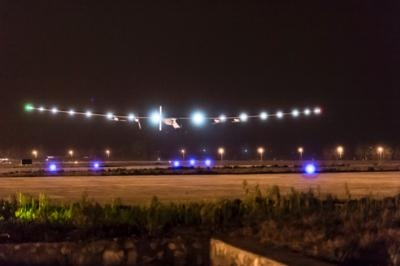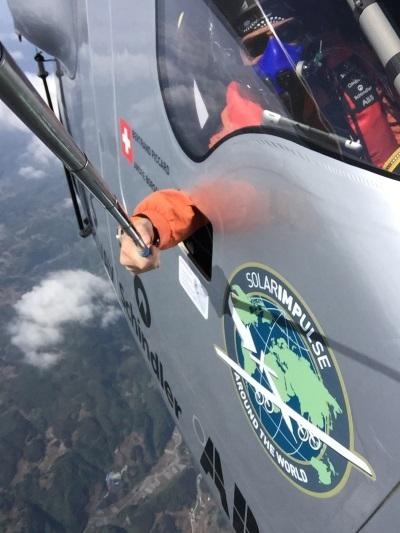Tue, Apr 28, 2015
Successfully Completes Leg 6 Of The First Round-The-World Solar Flight
Solar Impulse 2 (Si2) landed successfully in Nanjing, People’s Republic of China last week, following a 20 day stay in Chongqing.

“My job as a pilot was relatively easy. The preparatory measures however proved challenging for our team of weather specialists and engineers from Si’s Partner Altran at the Monaco Control Center. We simulated all possible trajectories and exhausted all different strategies to get Solar Impulse 2 in the air; from defining pit-stops at airports along the route, to different speeds, altitudes and holding patterns. Throughout the entire process, the Chinese authorities have been unfailingly helpful and open to our ideas. We are amazed by the spirit of our team and the willingness of our partners to help us achieve our goal: The first Round-The-World flight without fuel” said Bertrand Piccard, Solar Impulse Initiator and Chairman.
This journey was also essential from a technical perspective as it was used to verify and fine-tune final elements in the preparation of the Pacific Ocean crossing scheduled for early May, pending favorable weather conditions. This last leg is bringing Solar Impulse one step closer to an aviation first – the next part of the circumnavigation will require flying five consecutive days and nights in a solar-powered aircraft to cross the Pacific, a feat that has never been accomplished before.
“Nanjing represents a turning point in the entire mission; this is where everything comes together for us as pilots after initiating the project 12 years ago," Borschberg said. "This is the moment of truth where all the technical and human challenges will have to be overcome. We now have less than a month to mentally and physically prepare for what will be Solar Impulse’s longest flight to date: a five day and five night journey across the Pacific Ocean from Nanjing to Hawaii.”
In the coming months, Mr. Piccard and Mr. Borschberg will continue their expedition around the globe promoting a cleaner future (FutureIsClean.org). Given the low speed of the ultra-light aircraft, the round-the-world mission will demand over 500 flight hours—or nearly three weeks in the air, spread over five months, covering the roughly 22,000 mile journey. Si2 is the largest aircraft ever built with such a low weight, equivalent to that of a small car.
After crossing the Pacific Ocean, Solar Impulse will stop in the United States, and then either North Africa or Southern Europe, before returning to Abu Dhabi to complete the first ever round-the-world solar flight.
No departure date for the flight to Hawaii has been set.

More News
Also: ANOTHER Illegal Drone, KidVenture Educational Activities, Record Launches, TSA v Shoes The Senate confirmed Bryan Bedford to become the next Administrator of the FAA, in a ne>[...]
Also: Sully v Bedford, Embraer Scholarships, NORAD Intercepts 11, GAMA Thankful Middle Georgia State University will be joining the Federal Aviation Administration’s fight ag>[...]
Also: DarkAero Update, Electric Aircraft Symposium, Updated Instructor Guide, OSH Homebuilts Celebrate The long-awaited Sonex High Wing prototype has flown... the Sonex gang tells >[...]
Also: Sully v Bedford, Embraer Scholarships, NORAD Intercepts 11, GAMA Thankful Middle Georgia State University will be joining the Federal Aviation Administration’s fight ag>[...]
30-Year USCG Veteran Aviator Focusing On Member Benefits The Vertical Aviation International Board of Directors announced its new leadership officers in April, and all began their >[...]
 Airborne 07.11.25: New FAA Boss, New NASA Boss (Kinda), WB57s Over TX
Airborne 07.11.25: New FAA Boss, New NASA Boss (Kinda), WB57s Over TX Airborne-Flight Training 07.10.25: ATC School, Air Race Classic, Samson School
Airborne-Flight Training 07.10.25: ATC School, Air Race Classic, Samson School Airborne Affordable Flyers 07.03.25: Sonex HW, BlackShape Gabriel, PRA Fly-In 25
Airborne Affordable Flyers 07.03.25: Sonex HW, BlackShape Gabriel, PRA Fly-In 25 Airborne-Flight Training 07.10.25: ATC School, Air Race Classic, Samson School
Airborne-Flight Training 07.10.25: ATC School, Air Race Classic, Samson School Rick Kenin New Board Chair of VAI
Rick Kenin New Board Chair of VAI




